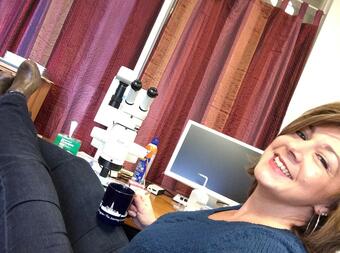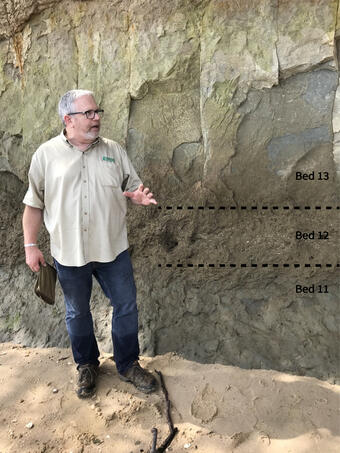Geological Investigations of the Neogene Project
Geological Investigations of the Neogene explores past warmer-than-modern climates of the mid-Miocene (about 14-17 million years ago) and Piacenzian (about 3 million years ago) to assess the potential environmental and economic impacts to population centers along the US Atlantic coast under different rates and magnitudes of changes related to warmer temperatures. Specifically, we look at past changes and rates of change in sea level, precipitation, ocean acidification, and storm activity and use climate, ecological, and coastal process modeling as guides to help determine how our infrastructure, fishing, shipping, agriculture, and tourism industries might be affected by modern warming. Rapid changes of the past provide valuable examples of ecological and shoreline behavior for coastal communities as they plan for the impacts of modern sea surface warming on coastal economies.

This project examines warm periods of the past in terms of the response of shallow marine ecosystems and physical changes in coastal zones along the US Atlantic coast. Past warm periods provide a baseline for the impact of changes to the shallow marine environment that can be used to prepare for the effects of the modern warming trend. Large segments of the US population live in coastal communities and rely heavily on the fisheries and tourism industries and national defense installations, and this research provides valuable data that can be used to develop strategies to successfully adapt to changes in the shallow marine environment and to the threat to infrastructure. Thus, this research has direct relevance to the economic stability of coastal population centers. We focus on intervals of past global warmth that are similar to our modern climate in terms of the rate of change and (or) magnitude of atmospheric CO2 concentration and average global temperature, primarily the Middle Miocene Climatic Optimum (MMCO, about 14-17 million years ago) and the mid-Piacenzian warm period (MPWP, about 3 million years ago). We compare these warm intervals and their impacts on the US Atlantic coast through documenting the rate and magnitude of sea level rise, coastal resilience, and biological sensitivity, recognizing the potential economic damage that modern sea level rise and ocean acidification can cause to coastal infrastructure and the fisheries and tourism industries. Furthermore, we look at the broader view of differences in North Atlantic latitudinal gradient and polar amplification, global carbon disruptions, ocean heat transfer efficiency, and global ice volume to better understand the overall climate system.

Our research answers major questions regarding regional variability in environmental change and ecosystem response. The USGS Florence Bascom Geoscience Center is geographically located within a few hours’ drive of multiple mid-Miocene and Piacenzian outcrops. In addition, we maintain a wealth of shallow marine core material from the Atlantic coastal region. Most importantly, we possess the expertise and professional networks to thoroughly analyze the response of critical ecosystems and coastal geomorphology to regional environmental change. Our research informs the scientific community, policy-makers and the general public by providing products that reconstruct the shallow marine environments across the US Atlantic coastline before, during and after intervals of abrupt and (or) profound climate change. Our data assist in evaluating the potential consequences of modern warming and provide boundary conditions for modeling efforts. Our main objectives are to investigate the biotic patterns of marine fauna surrounding Neogene warm intervals to better understand the range of potential changes possible under past and future change scenarios. In addition, we support 14 ongoing climate model experiments, assemble and reconstruct paleoenvironmental data sets for verification of experimental results for IPCC, and provide a data-model comparison of the individual and multi-model ensembles.
Geological Investigations of the Neogene explores past warmer-than-modern climates of the mid-Miocene (about 14-17 million years ago) and Piacenzian (about 3 million years ago) to assess the potential environmental and economic impacts to population centers along the US Atlantic coast under different rates and magnitudes of changes related to warmer temperatures. Specifically, we look at past changes and rates of change in sea level, precipitation, ocean acidification, and storm activity and use climate, ecological, and coastal process modeling as guides to help determine how our infrastructure, fishing, shipping, agriculture, and tourism industries might be affected by modern warming. Rapid changes of the past provide valuable examples of ecological and shoreline behavior for coastal communities as they plan for the impacts of modern sea surface warming on coastal economies.

This project examines warm periods of the past in terms of the response of shallow marine ecosystems and physical changes in coastal zones along the US Atlantic coast. Past warm periods provide a baseline for the impact of changes to the shallow marine environment that can be used to prepare for the effects of the modern warming trend. Large segments of the US population live in coastal communities and rely heavily on the fisheries and tourism industries and national defense installations, and this research provides valuable data that can be used to develop strategies to successfully adapt to changes in the shallow marine environment and to the threat to infrastructure. Thus, this research has direct relevance to the economic stability of coastal population centers. We focus on intervals of past global warmth that are similar to our modern climate in terms of the rate of change and (or) magnitude of atmospheric CO2 concentration and average global temperature, primarily the Middle Miocene Climatic Optimum (MMCO, about 14-17 million years ago) and the mid-Piacenzian warm period (MPWP, about 3 million years ago). We compare these warm intervals and their impacts on the US Atlantic coast through documenting the rate and magnitude of sea level rise, coastal resilience, and biological sensitivity, recognizing the potential economic damage that modern sea level rise and ocean acidification can cause to coastal infrastructure and the fisheries and tourism industries. Furthermore, we look at the broader view of differences in North Atlantic latitudinal gradient and polar amplification, global carbon disruptions, ocean heat transfer efficiency, and global ice volume to better understand the overall climate system.

Our research answers major questions regarding regional variability in environmental change and ecosystem response. The USGS Florence Bascom Geoscience Center is geographically located within a few hours’ drive of multiple mid-Miocene and Piacenzian outcrops. In addition, we maintain a wealth of shallow marine core material from the Atlantic coastal region. Most importantly, we possess the expertise and professional networks to thoroughly analyze the response of critical ecosystems and coastal geomorphology to regional environmental change. Our research informs the scientific community, policy-makers and the general public by providing products that reconstruct the shallow marine environments across the US Atlantic coastline before, during and after intervals of abrupt and (or) profound climate change. Our data assist in evaluating the potential consequences of modern warming and provide boundary conditions for modeling efforts. Our main objectives are to investigate the biotic patterns of marine fauna surrounding Neogene warm intervals to better understand the range of potential changes possible under past and future change scenarios. In addition, we support 14 ongoing climate model experiments, assemble and reconstruct paleoenvironmental data sets for verification of experimental results for IPCC, and provide a data-model comparison of the individual and multi-model ensembles.

